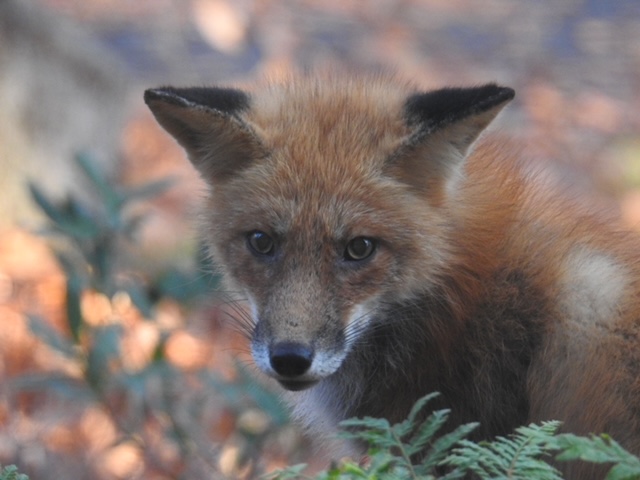
Red Fox photographed by Avery Stirratt
Our natural landscapes and backyards are part of a complex food chain in which mammals occupy the highest echelon. Some animals that live among us are highly visible. Others are nocturnal and rarely seen, and a few wandering species, such as black bears and bobcats, are most likely only occasional visitors here. Yet they all fill a niche in our ecosystem and take full advantage of what Nature has to offer.
Which ones are strict vegetarians? Which ones are only carnivorous? How many are opportunistic omnivores? Here is a look at the diets of twenty-five of the most common suburban-dwelling mammals in New Canaan.
Strict Vegetarians
Strict vegetarians include white-tailed deer, white-footed mice, meadow voles, porcupines, and Eastern cottontails. They eat a variety of plants, leaves, flowers, buds, fruits, seeds, nuts, and mushrooms. Surprisingly, none of these vegetarians hibernate during the cold months. Their diet changes with the seasons as different foods become available. In winter, mice and voles eat mostly bark and roots, while deer, cottontails, and porcupines eat bark, branches, and twigs. Porcupines even eat pine needles.
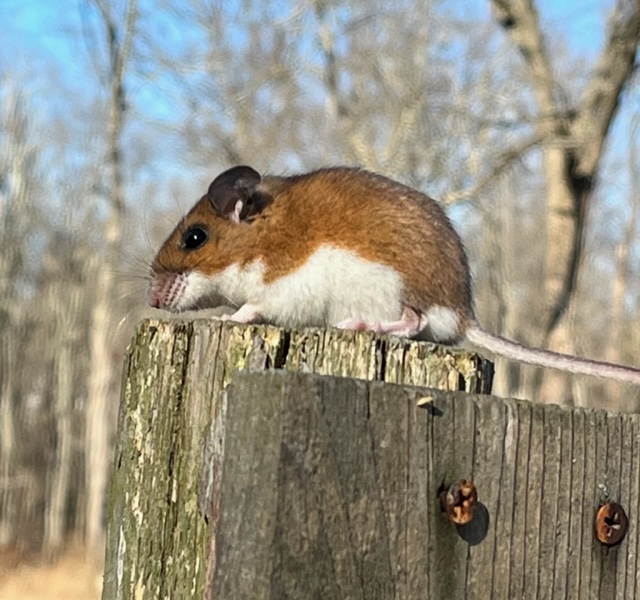
White-footed mouse photographed by Susan Bergen
Carnivores

Bobcat photographed by Paul Bamatter
Strict carnivores include bobcats, short-tailed weasels, river otters, star-nosed moles, short-tailed shrews, and little brown bats. All are voracious predators.
Bobcats, the largest predator in this group, catch insects, mice, voles, rats, chipmunks, squirrels, rabbits, skunks, woodchucks, birds, and occasionally fawns. They remain active all year; the males, in particular, range over several square miles. Females roam as well but stay within a mile or so of their dens when raising their young.
Short-tailed weasels go for small rodents, insects, frogs, fish, birds, eggs, and backyard chickens. As weasels are unable to store fat in their bodies, they must constantly search for food all year long. Chipmunks, who semi-hibernate in underground winter dens, are especially vulnerable to predation by weasels.
River otters live in ponds and along stream banks. Aquatic species such as fish, crayfish, frogs, turtles, and water-dwelling invertebrates make up their main diet. They are also known to catch small rodents and birds. When ponds freeze in the winter, otters hunt for fish underwater beneath the ice.
The three remaining carnivores rely on a diet of insects and invertebrates. Little brown bats, which feed on flying insects, such as mosquitoes, gnats, wasps, and midges, are compelled to hibernate in winter when their food source is unavailable.
Shrews spend most of their time tunneling underground, even in snow banks, searching for beetles, larvae, slugs and snails, worms, centipedes, and millipedes. They are known to eat carrion as well.
Star-nosed moles seek out earthworms, grubs, leeches, and tiny fish. Surprisingly, they are expert swimmers!
The Full Plate
The omnivores make up the largest group of our backyard animals. They are both predators and foragers.
Eastern coyotes, and red and gray foxes, hunt for small game, including mice, rabbits, squirrels, and chipmunks. They also catch fish, frogs, snakes, birds, grasshoppers, beetles, moths, and butterflies. Fruits, vegetables, seeds, nuts, and mushrooms round out their diet. And carrion is always a draw. Coyotes may take down a young or infirm deer if the opportunity arises, but they generally stick with smaller prey.

Raccoon photographed by Avery Stirratt
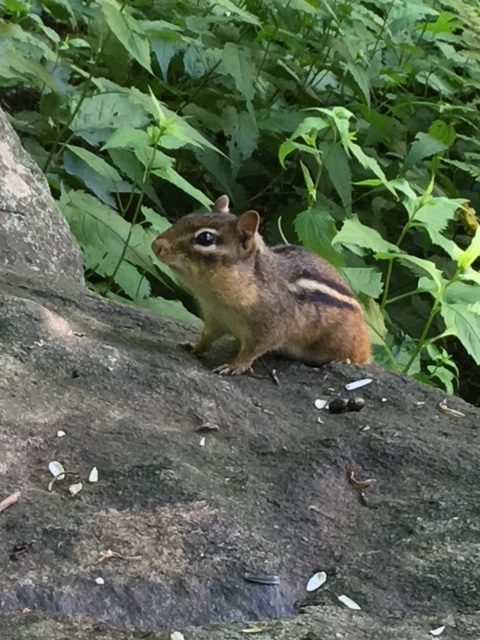
Chipmunk photographed by Susan Bergen
Chipmunks store caches of nuts and seeds for winter hibernation. While they spend the cold months in underground dens, they don’t sleep all winter long. They must wake up periodically to eat in order to maintain their body weight. If the winter is particularly long and harsh, and they haven’t stored enough food, they will starve.
Groundhogs, the bane of many gardeners, eat copious amounts of flowers and vegetables and dandelions, clover, alfalfa, roots, and bark. While they are mostly vegetarian, they also dine on insects, grasshoppers, snails, and grubs. In late summer into fall, groundhogs eat voraciously to put on pounds in order to store up large amounts of fat reserves, which enable them to go into true hibernation without eating all winter.
Striped skunks, Virginia opossums, and raccoons eat a variety of small prey, plus insects, grubs, fruits, berries, and garbage. They remain active throughout the year.
Muskrats are pond dwellers that thrive on aquatic plants, such as cattails, sedges, rushes, pickerel weed, and sweet flag. They also hunt for freshwater mussels, crayfish, frogs, snails, and fish. Muskrats live in underground burrows along the banks of ponds. While the pond may freeze over in winter, they do not hibernate or store food. They hunt underwater under the ice, as otters do.
Black bears, like all omnivores, are opportunistic feeders. They are primarily vegetarian and known to eat grasses, roots, berries, mushrooms, acorns, and other nuts. They love bees and their honey, as well as yellow jackets, ants, and larvae. If the opportunity presents itself, they will catch fish and small mammals.
Sustaining Natural Food Webs
Of these twenty-five mammals: five are strict vegetarians, six are carnivores, and fourteen are omnivores. Nineteen eat plants, and seventeen eat insects. Amazingly, insects account for 23% of a black bear’s and 25% of a red fox’s diet.
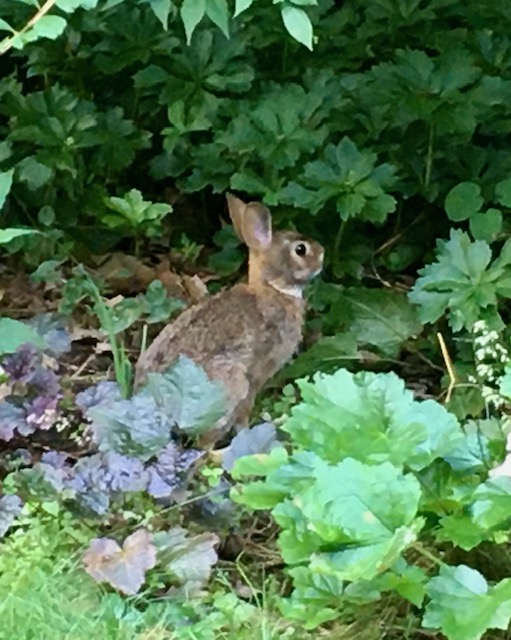
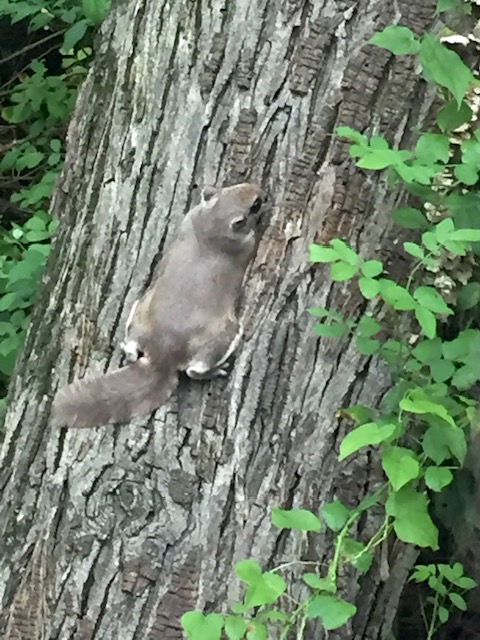
Eastern cottontail and flying squirrel photographed by Susan Bergen
Our plant and animal worlds intersect every day. Wildlife sanctuaries and open space preserves are key to sustaining the food webs of the creatures that live among us. Protected woodlands, meadows, ponds, streams, and wetlands also provide shelter and places for these animals to nest or den and raise their young. Backyard habitats are equally important. Individual properties link isolated conservation lands and create wildlife corridors that enable species to move about freely, find food, establish new territories and thrive.
Great article Susan! Perhaps a member engagement idea could be to have a place on the site for people to report mammals and bird sightings on the preserves. We could report out a couple times a year or seasonally.